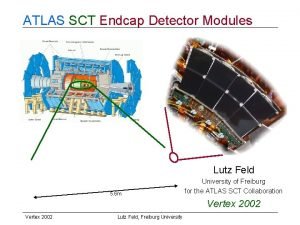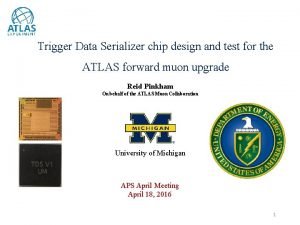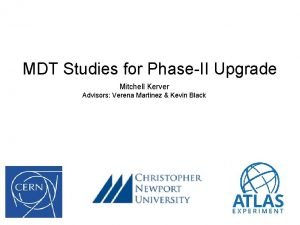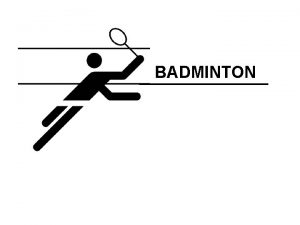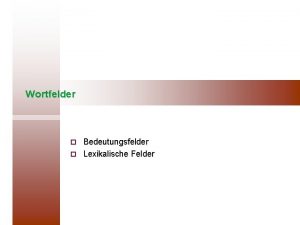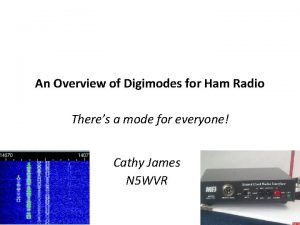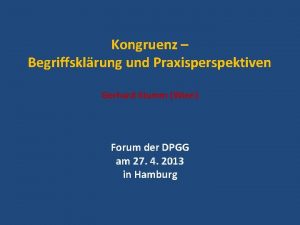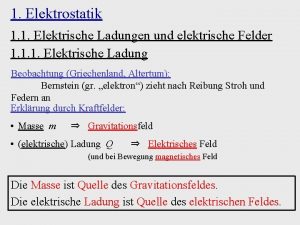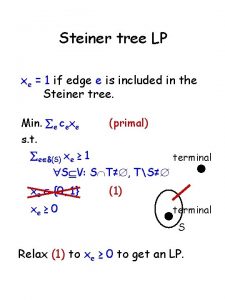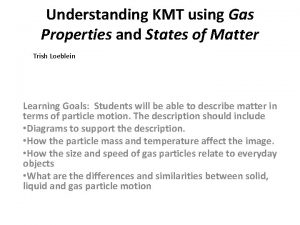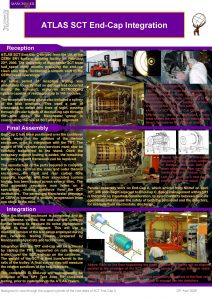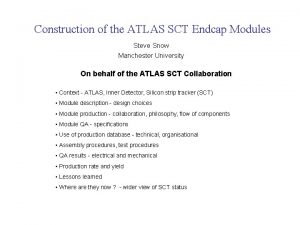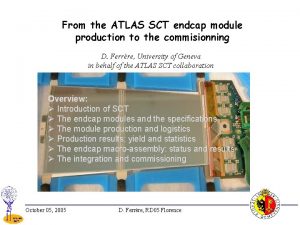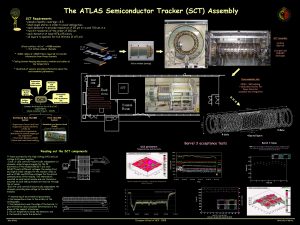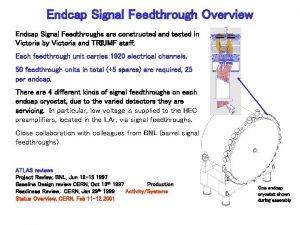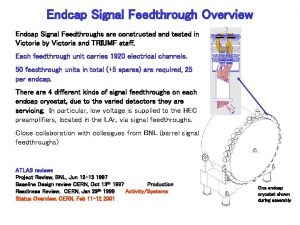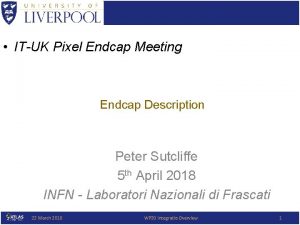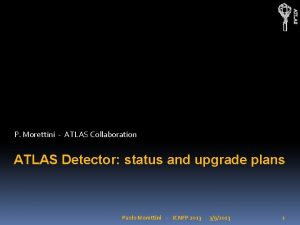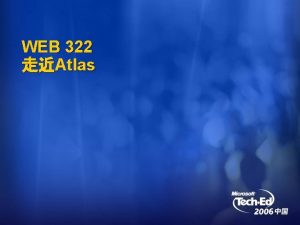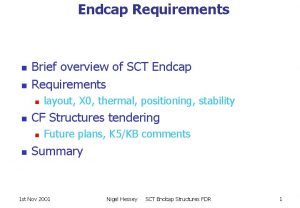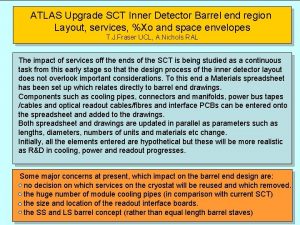ATLAS SCT Endcap Detector Modules Lutz Feld 5













- Slides: 13

ATLAS SCT Endcap Detector Modules Lutz Feld 5. 6 m University of Freiburg for the ATLAS SCT Collaboration Vertex 2002 Lutz Feld, Freiburg University

Endcap Disks covered by 3 Rings of Modules cooling block outer modules middle modules (on backside) power tapes inner modules • • • 9 disks in each endcap, ~1. 2 m diameter CF structure 132 detector modules on a full disk, 1976 endcap modules in total modules have central mounting and cooling point module overlap easy each module serviced by a power tape and 3 optical fibres evaporative cooling circuits serve up to 13 modules Vertex 2002 Lutz Feld, Freiburg University 2

3 Module Types outer module (52 per ring) inner module (40 per ring) middle module (40 per ring) Vertex 2002 Lutz Feld, Freiburg University 3

Endcap Module Design: Silicon Sensors strip direction 4 wedge shape silicon sensors 768 p-in-n strips, single sided supplied by Hamamatsu and Ci. S sensor alignment < 5µm strip direction Vertex 2002 Lutz Feld, Freiburg University 40 mrad stereo angle 4

Endcap Module Design: „Spine“ strip direction sensors are glued to „spine“: TPG bar for heat removal (1700 W/m/K) mounting points and cooling contacts Al. N wings for mechanical stability strip direction Vertex 2002 Lutz Feld, Freiburg University 5

Endcap Module Design: Hybrid 12 ABCD 3 TA binary read-out chips (DMILL) hybrid connected to sensors only by fanins thermal split strip direction hybrid: flex circuit on carbon-carbon strip direction Vertex 2002 Lutz Feld, Freiburg University 6

Hybrid • development of hybrid was critical and needed several iterations • very low impedance is key for successful operation of binary ABCD chips • requirements: • double sided, 12 readout chips • supply well filtered analogue/digital power • com/data lines and drivers for optical link • detector bias supply (up to 500 V) • heat removal (7 W) • low mass • implementation: • 6 layer copper/Kapton flex circuit • ~75µm feature size, ~3000 micro vias • flex folded around carbon-carbon substrate • full assembly and basic testing in industry Vertex 2002 Lutz Feld, Freiburg University 7

Thermal Performance of Endcap Module • evaporative C 3 F 8 cooling system, capable to cool down to – 30°C • central module cooling block, split between hybrid and detectors, long modules have additional far end cooling block • detailed simulations, confirmed by measurements of non-irradiated and irradiated modules on an evaporative cooling test rig detector temperature vs. radiation damage for coolant at – 21°C inner module expected after 10 years Vertex 2002 outer module expected after 10 years Lutz Feld, Freiburg University 8

Electrical Performance • binary front-end chip occupancy vs. threshold „s-curves“ • signal height and noise are derived from „s-curves“ • relevant for operation: hit efficiency and noise occupancy • noise occupancy determined by – front-end noise (fixed for given ASIC and detector) – channel-to-channel threshold variations (threshold trim per channel) – additional noise: common mode, feedback etc. (the difficult part. . . ) occupancy vs. channel and threshold Vertex 2002 occupancy vs. threshold Lutz Feld, Freiburg University 9

16 Prototype Modules • 9 outer, 2 middle, 5 inner • modules built reliably inside tolerances, in several institutes threshold spread • noise 1500 e or less • noise occupancy @1 f. C: ~10 -5 • gain ~50 m. V/f. C • threshold spread 150 e ENC noise Vertex 2002 gain Lutz Feld, Freiburg University 10

System Test: 4 Modules on a Disk Sector noise for each chip when operated simultaneously singly common mode noise with 4 modules on disk • no extra noise • common mode noise negligible Vertex 2002 Lutz Feld, Freiburg University 11

Testbeam Results • binary read-out: efficiency and noise occupancy at given threshold • spec: single hit efficiency > 99% while noise occupancy < 5 E-4 • long modules before / after irradiation to 1. 6 or 3. 3 E 14 24 Ge. V-p/cm 2 in a beam of 180 Ge. V pions • 10 years LHC operation ~2. 6 E 14 p/cm 2 non-irradiated @ 150 V bias 1. 6 E 14 24 Ge. V-p/cm 2 @ 480 V bias 3. 3 E 14 24 Ge. V-p/cm 2 @ 480 V bias • spatial resolution of 23µm achieved, as expected from pitch/sqrt(12) Vertex 2002 Lutz Feld, Freiburg University 12

Summary & Outlook • ATLAS SCT endcap modules final design review in August 02 • now preparing for production of 2000 modules (+spares): – ASICs and detectors: ~80% delivered – hybrid: pre-series of 100 pieces in production, first samples delivered; for production: full assembly and basic testing in industry – spines and fan-ins: pre-series in production, first samples delivered; production can start soon • module assembly and QA at 7 sites – good experience with assembly of prototype modules (>20) – preparation of production tooling and qualification over next months – production will take about 1. 5 years Vertex 2002 Lutz Feld, Freiburg University 13
